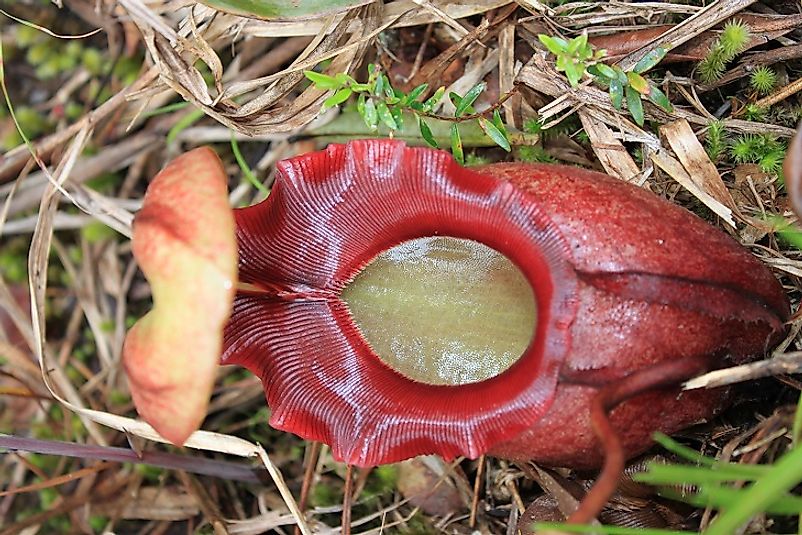Native Plants Of Malaysia

Malaysian Borneo and Sulawesi are regions especially rich in unique and endemic species of flora. The lowland rainforests and mountain rain forests provide suitable environmental conditions for the growth of a broad range of native plants. Mount Kinabalu and the islands of Sabah offer a diversified ecosystem for the growth of these plants. Some of the native flora of Malaysia includes Sabah Highlands Pitcher Plant, an insectivorous species with a large pitcher for trapping insects and smaller vertebrates. The Sabahan Yellowwood Pine is a coniferous species endemic to Malaysia. Southwest Sulawesi Tree Fern is a plant species endemic to Sulawesi and Maluku Islands.
Sabahan Yellowwood Pine (Podocarpus globules)
Podocarpus globules, also known as the Sabahan Yellowwood Pine, is a conifer species of the Podocarpaceae Family that is endemic to Malaysia. The conifer rises to 27 meters tall with straight and round trunks and branches spreading to a rounded crown. Earlier on during development the bark is smooth and brown in color but later it develops flanky scales. The twigs are round and slightly grooved with compacts mounted buds about 2 to 3 millimeters in diameter. The leaves on mature canopies are straight and coriaceous while the seed cones are auxiliary with small crested a green to dark brown seed. The plant grows in lower to middle altitude ranges of 310 to 1,530 meters above sea level. It prefers montane rainforests growing on ridges and summits where the dipterocarp is not dominant. The plant is rare known from four major localities that are not protected. Human exploits the plant for its podocarp timber. Also, deforestation exposes these conifers to more harvesting.
Mount Kinabalu Yellowwood Pine (Podocarpus brevifolius)
Podocarpus brevifolius, commonly known as the Mount Kinabalu Yellowwood Pine, also belongs to the Podocarpaceae Family. The plant is native to the ridges of Sabah and Mount Kinabalu Malaysia. It is an evergreen type of plant with a thin, grayish yellow, fibrous but smooth bark. The inner parts are aromatic with a red-brown coloring. The leaves have an alternate arrangement, are coriaceous, oblong-elliptic with the upper side green and lower side is greenish. The cones are dioecious, with male cones being spiky and solitary or in 2 to 3 fascicles and sessile and axillary, while females’ cones are solitary and axillary. The plant flowers twice each and the seed have a fleshy and globose appearance. The plant prefers the evergreen tropical broad-leaved forests or subtropical forests with an altitude range of 900 to 1500 meters in elevation. The International Union for the Conservation of Nature (IUCN) describes the tree as vulnerable to extinction more so since the population is subtle in the wild and has a restricted distribution. Humans harvest the tree for its timber which is dark brown, straight and beautiful, thick and hard resistant to decay. Used in construction such as bridges, making of musical instruments, house building, and carvings.
Sabah Highlands Pitcher Plant (Nepenthes rajah)
Nepenthes rajah, commonly known as the Sabah Highlands Pitcher Plant, is an insectivorous plant species belonging to the Nepenthaceae Family. The plant is native to Mount Kinabalu, Mount Tambuyukon in Malaysia. The plant grows on serpentine substrates in loose soil with seeping ground water. It grows at altitudel ranges of 1500 to 2650 meters above sea level. The IUCN describes the plant as an endangered species due to its localized distribution. The pitcher plant produces large urn-shaped traps holding up to 2.5 liters of digestive juices. The plant traps vertebrates and small mammals like rats, vertebrates like frogs, lizards, and small birds. However, insects are the staple prey for both terrestrial and aerial pitchers. The Nepenthes rajah is a scrambling vine with stems usually growing along the ground and climb when it gets an object to support it. The stem usually grows to three meters but can grow to six meters. The leaves have a sheathed petiole with long tendrils where a pitcher develops. The flowers are brownish-yellow, giving off a strong aromatic smell. The plant is monoecious. The fruits are orange-brown and 10 to 20 millimeters long with numerous winged seeds.
Southwest Sulawesi Tree Fern (Cyathea inquinans)
Cyathea inquinans, known as the Southwest Sulawesi Tree Fern, is a plant found in the Sulawesian and Maluku Islands. It has an erect trunk growing to heights of 2 to 4 meters. The fronts are either bipinnate or tripinnate with 1 meter in length. Scales cover the stripes. The scales are large and red-brown in color or thin, with narrow, delicate edges and have a red apical. A Sorus appears near the pinnule midvein. Light brown indusials protect these Sori. The species grows in altitude ranges of 2000 to 2800 meters in montane forests.
Conservation of Malaysian Flora
The mountainous ridges and forests of Malaysia provide optimal environmental conditions for the growth and survival of these and other native plant species. However, most of these plants grow in lower to middle elevations and are thus prone to human encroachment. Clearing of forest for agriculture or illegal logging also threatens the habitats of these species.
Native Plants Of Malaysia
| Native Plants of Malaysia | Scientific Name |
|---|---|
| Southwest Sulawesi Tree Fern | Cyathea inquinans |
| Dark Red Meranti | Shorea acuminata |
| Black Rabbit Foot's Fern | Davallia trichomanoides |
| Sabahan Yellowwood Pine | Podocarpus globulus |
| Malaysian Blackwood | Diospyros ebonasea |
| Malaysian Mangosteen | Garcinia eugeniaefolia |
| Mount Kinabalu Yellowwood Pine | Podocarpus brevifolius |
| Wild Areca Palm | Areca triandra |
| Sabah Highlands Pitcher Plant | Nepenthes rajah |
| Durian | Durio zibethinus |







